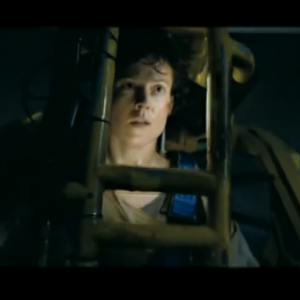
It wasn’t pretty, and it wasn’t mil-spec, but Ripley led the way for women in powered armor in her fight with the alien queen.
(Source: © 1986 Twentieth Century Fox. All Rights Reserved)
There was a time when women in revealing bits of chain mail and armor graced the covers of fantasy novels was all the rage, but that was fantasy. Science fiction’s take on armor has always been more both more male and more practical, going back to Kimball Kinnison’s assault on Helmuth’s fortress (Galactic Patrol, E.E. Smith, 1950) perhaps, but forever defined by the opening sequence of Heinlein’s Starship Troopers (1959) when he defines both orbital drop troops and powered armor in one breathtaking, hard sf, swoop. Though the movie made for Starship Troopers missed the critical signature element, the game and novel universe of Halo has done an excellent job with both armor and orbital insertion, in their ODST (Obrital Drop Shock Troops) and Spartans.
Of course, armor is a natural for fictional male characters, because it allows illustrators to bulk up their physiques with more muscular shapes, while female characters need to keep their curves to draw the eye. Fortunately, it’s not always the boys that get the shiny toys.
Interestingly, movies managed to get ahead of written sf on this one, though the exoskeleton that Ripley climbs into to fight the Alien at the end of Aliens isn’t military armor, she put it to good use just the same.
Women in armor makes good sense. If women are, on average, neither as big or strong as men, powered armor is a perfect match, since it means that less energy is wasted dragging the operator around. Of course, that goes double for dwarfs, and I actually started a short story about that…but I digress.
Mercenary Devi Morris gets the last licks in with Heaven’s Queen, the final book in Rachel Bach’s mil-sf/romance mashup. Sure, she saves the universe, but she’s just not marine material.
Recently I finished Heaven’s Queen, the conclusion of Rachel Bach’s Paradox trilogy featuring Devi Morris, the hard-core mercenary who loves her custom made armor more than almost anything else, at least until she meets her one true love. I’ll review that elsewhere, but as you’ve no doubt guessed, I’m not happy about this particular mingling of mil-sf and romance fiction. The armor itself, always kept in shining glory, isn’t badly done, though the nano-tech repair case that it comes with to restore it after Devi repeatedly gets it banged up seems like a cheat, and the cover illustrations never got the news that it doesn’t have a glass faceplate. The failure of the story for me is in the main character, who doesn’t get the band of brothers concept at all, which is what separates mil fiction, be it sf or not, from the rest. Sf has been accused of being fantasy with the bolts pained on, and this is a case where that’s painfully true, complete with the main character’s worship of her planet’s king and fervent desire to become one of his elite guard.

“Seriously. Get me a gun, I’m a soldier . Get that suit for me, I’m a superhero.” “If we’ve still got it , you’ll have it.” “All right, then,” Bobbie said. She smiled. For the first time since they’d met, Avasarala was afraid of her. God help whoever makes you put it on.
Corey, James S.A. (2012-06-26). Caliban’s War (The Expanse) (p. 317). Orbit. Kindle Edition.
On the other hand, James S. A. Corey, the sf fusion of writers Daniel Abraham and Ty Franck, manages to put ordinance directly on target with their portrayal of Gunnery Sergeant Bobbie Draper of the Martian Marines in the second book of their Expanse trilogy, Caliban’s War. I have a hard time reconciling that Orbit brought out both books, and plugged the first at the end of the last book in the Expanse. One of these things is really not like the other, despite the girl in powered armor and alien symbiont bad guys.
Bobbie’s suit isn’t something you’d wear around the house, despite being designed for boarding operations. It’s not state of the art, because she’s a big girl and can’t find a new one that fits her, so like Devi, she’s very attached to it. The hardware details here are a lot more convincing that in Bach’s series, but then, Caliban’s War is set in a moderately near future which allows for direct extrapolation of real hardware. As such the main weapon up Bobbie’s sleeve is described as a Gatling Gun, rather than the plasma shotgun Devi ripped off a tank and affectionately totes around, or the “disruptor pistol” that the bad guys prefer.
As a character, Bobbie’s a lot easier to respect than Devi as well. She manages to cross gender lines without losing her identity, both a very believable marine and as a female dealing with boys with issues. If young women want a role model, I’d nominate Bobbie in a heartbeat. We meet her on patrol when a “monster” takes out her squad with superhuman speed and strength, leaving her the sole survivor and driven by that guilt as well as a generous helping of PTSD. Despite everything, she keeps putting one foot in front of the other to get the job done and there’s no question in my mind that Heinlein would have been proud to have her in Rico’s Roughnecks or that Ripley would have had any problem with her watching her back.